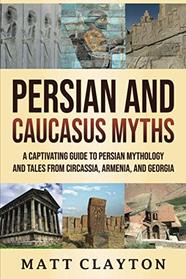The myth author/compiler has done a fine job explaining unusual terms and 'setting the stage' for the tales. The language also flows well and all of the tales are very interesting. In one instance, the myth has been converted from poetry to prose, for ease of understanding.
In the early days of reading these mythology books, I really wasn't much interested in the subject. As I've continued to read more, I've become absolutely fascinated by the variety and complexity of the thinking behind these tales of creation, the discovery of necessary skills/implements for human life, and tales to explain a culture's belief systems.
PERSIAN MYTHOLOGY --
During the years 3000 through 2001 BC, a group of people moved from India to a large area, generally called Iran today. They referred to themselves as 'Aryan' (having nothing to do with that Nazi designation later). This was based on their religious, cultural, and linguistic relationships. Their religious practices became integrated with the Persian native religion of Zoroastrianism (founded ~ 1500 - 1000 BCE by Zarathustra - or Zoroaster). Zoroastrianism is a dualist religion, essentially pitting a beneficent creator, who vies with an evil being (who tries to destroy).
This book is broken into three parts. The author kindly explains the background of the story about to be told. Generally, the author explains where the story comes from. Then comes a collection of stories compiled by a Persian author (Marvazi) around the turn of the 7th century. There is a frame story that tells about Prince Bakhtiyar, from his birth, abandonment by his royal parents, to his eventual reunion with his family. Within the frame story, we find two internal tales. In the last section of Persian mythology are tales of ancient and probably mythical kings who discover things necessary to human survival (such as fire or clothing).
CAUCASUS MYTHOLOGY --
The Caucasus region's mythology is a combination of native pagan tradition and influences from ancient Greek and Persian cultures. Other influences were the medieval knightly culture and romance, as well as Christianity and Islam. Some of the oldest tales are related to the Narts sagas (ancient Caucasian gods). The first part of this book contains myths and legends.
The second part provides the reader with differing versions of two national epics from the Caucasus. The first epic is Armenian, "David of Sassoun." This is the four-generational story of a single-family. Persian culture intermingles with that of Armenia. In this story, the 'devs' (evil demon-like beings) are from Persian culture but eventually adopted into the mythologies of surrounding nations.
Second, comes an abbreviated version of a medieval Georgian epic, "The Knight in the Panther's Skin." It was originally written in the poetical form in the medieval romance tradition. For ease of understanding, this has been abbreviated and converted to prose. This myth was written much later than the first epic, "David of Sassoun."
In the early days of reading these mythology books, I really wasn't much interested in the subject. As I've continued to read more, I've become absolutely fascinated by the variety and complexity of the thinking behind these tales of creation, the discovery of necessary skills/implements for human life, and tales to explain a culture's belief systems.
PERSIAN MYTHOLOGY --
During the years 3000 through 2001 BC, a group of people moved from India to a large area, generally called Iran today. They referred to themselves as 'Aryan' (having nothing to do with that Nazi designation later). This was based on their religious, cultural, and linguistic relationships. Their religious practices became integrated with the Persian native religion of Zoroastrianism (founded ~ 1500 - 1000 BCE by Zarathustra - or Zoroaster). Zoroastrianism is a dualist religion, essentially pitting a beneficent creator, who vies with an evil being (who tries to destroy).
This book is broken into three parts. The author kindly explains the background of the story about to be told. Generally, the author explains where the story comes from. Then comes a collection of stories compiled by a Persian author (Marvazi) around the turn of the 7th century. There is a frame story that tells about Prince Bakhtiyar, from his birth, abandonment by his royal parents, to his eventual reunion with his family. Within the frame story, we find two internal tales. In the last section of Persian mythology are tales of ancient and probably mythical kings who discover things necessary to human survival (such as fire or clothing).
CAUCASUS MYTHOLOGY --
The Caucasus region's mythology is a combination of native pagan tradition and influences from ancient Greek and Persian cultures. Other influences were the medieval knightly culture and romance, as well as Christianity and Islam. Some of the oldest tales are related to the Narts sagas (ancient Caucasian gods). The first part of this book contains myths and legends.
The second part provides the reader with differing versions of two national epics from the Caucasus. The first epic is Armenian, "David of Sassoun." This is the four-generational story of a single-family. Persian culture intermingles with that of Armenia. In this story, the 'devs' (evil demon-like beings) are from Persian culture but eventually adopted into the mythologies of surrounding nations.
Second, comes an abbreviated version of a medieval Georgian epic, "The Knight in the Panther's Skin." It was originally written in the poetical form in the medieval romance tradition. For ease of understanding, this has been abbreviated and converted to prose. This myth was written much later than the first epic, "David of Sassoun."




